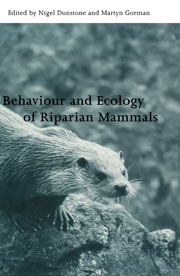Book contents
- Frontmatter
- Contents
- List of contributors
- Preface
- 1 Adaptations to the semi-aquatic habit and habitat
- 2 Physiological challenges in semi-aquatic mammals: swimming against the energetic tide
- 3 Diving capacity and foraging behaviour of the water shrew (Neomys fodiens)
- 4 Habitat use by water shrews, the smallest of amphibious mammals
- 5 The importance of the riparian environment as a habitat for British bats
- 6 A preliminary study of the behaviour of the European mink Mustela lutreola in Spain, by means of radiotracking
- 7 The demography of European otters Lutra lutra
- 8 Habitat use and conservation of otters (Lutra lutra) in Britain: a review
- 9 The relationship between riverbank habitat and prey availability and the distribution of otter (Lutra lutra) signs: an analysis using a geographical information system
- 10 Influence of altitude on the distribution, abundance and ecology of the otter (Lutra lutra)
- 11 Diets of semi-aquatic carnivores in northern Belarus, with implications for population changes
- 12 Otter (Lutra lutra) prey selection in relation to fish abundance and community structure in two different freshwater habitats
- 13 Diet, foraging behaviour and coexistence of African otters and the water mongoose
- 14 Feeding ecology of the smooth-coated otter Lutra perspicillata in the National Chambal Sanctuary, India
- 15 Population trends of hippopotami in the rivers of the Kruger National Park, South Africa
- 16 Reproductive strategies of female capybaras: dry-season gestation
- 17 The continuing decline of the European mink Mustela lutreola: evidence for the intraguild aggression hypothesis
- 18 Otters and pollution in Spain
- 19 The rapid impact of resident American mink on water voles: case studies in lowland England
- 20 Status, habitat use and conservation of giant otter in Peru
- Index
19 - The rapid impact of resident American mink on water voles: case studies in lowland England
Published online by Cambridge University Press: 03 May 2010
- Frontmatter
- Contents
- List of contributors
- Preface
- 1 Adaptations to the semi-aquatic habit and habitat
- 2 Physiological challenges in semi-aquatic mammals: swimming against the energetic tide
- 3 Diving capacity and foraging behaviour of the water shrew (Neomys fodiens)
- 4 Habitat use by water shrews, the smallest of amphibious mammals
- 5 The importance of the riparian environment as a habitat for British bats
- 6 A preliminary study of the behaviour of the European mink Mustela lutreola in Spain, by means of radiotracking
- 7 The demography of European otters Lutra lutra
- 8 Habitat use and conservation of otters (Lutra lutra) in Britain: a review
- 9 The relationship between riverbank habitat and prey availability and the distribution of otter (Lutra lutra) signs: an analysis using a geographical information system
- 10 Influence of altitude on the distribution, abundance and ecology of the otter (Lutra lutra)
- 11 Diets of semi-aquatic carnivores in northern Belarus, with implications for population changes
- 12 Otter (Lutra lutra) prey selection in relation to fish abundance and community structure in two different freshwater habitats
- 13 Diet, foraging behaviour and coexistence of African otters and the water mongoose
- 14 Feeding ecology of the smooth-coated otter Lutra perspicillata in the National Chambal Sanctuary, India
- 15 Population trends of hippopotami in the rivers of the Kruger National Park, South Africa
- 16 Reproductive strategies of female capybaras: dry-season gestation
- 17 The continuing decline of the European mink Mustela lutreola: evidence for the intraguild aggression hypothesis
- 18 Otters and pollution in Spain
- 19 The rapid impact of resident American mink on water voles: case studies in lowland England
- 20 Status, habitat use and conservation of giant otter in Peru
- Index
Summary
Introduction
The water vole (Arvicola terrestris; Arvicolinae) is a 250–300 g herbivorous rodent that inhabits the banks of freshwater–courses in Britain. In contrast, a fossorial form, Arvicola terrestris scherman, predominates in central Europe, co–existing with the aquatic form in the rest of Europe. The water vole is adapted to live in burrows, to swim and dive. In Britain it is largely associated with steep riverbanks, with abundant grass and layered vegetation (Lawton & Woodroffe, 1991). Woodall (1993) reported that in English Midland rivers such as the Thames, water vole presence was positively correlated with water depth and with the herbs Urtica sp. and Phragmites sp. and negatively correlated with bank height, bank depth and with herbs of the genera Polygonum., Phalaris, Sparganium and Juncus.
Several lines of evidence suggest that water vole populations have been declining in Britain at least since 1900. Jefferies et al. (1989) analysed the data contained in County Mammal Reports and literature from the beginning of the century onwards. These were supplemented by a questionnaire survey and by site descriptions from the Waterways Bird Survey organized by the British Trust for Ornithology (BTO). The literature search showed that, formerly, water voles had often been very abundant in all regions of Britain, except South Wales and Northern Scotland. However, by the late 1980s a general perception prevailed that water voles were becoming less numerous. The use of the word ‘common’ in descriptions of populations decreased from 1900 to 1985.
- Type
- Chapter
- Information
- Behaviour and Ecology of Riparian Mammals , pp. 339 - 358Publisher: Cambridge University PressPrint publication year: 1998
- 9
- Cited by



